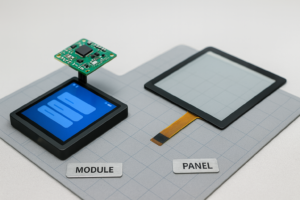Interactive Touch Screens for POS Terminals: Enhancing User Experience
Businesses are continuously seeking better ways to improve customer interaction and streamline their operations. One of the most effective ways to do this is through the use of interactive touch screens, especially in Point of Sale (POS) terminals. This technology is becoming increasingly popular in various sectors such as retail, hospitality, and self-service industries. Touch screens offer an efficient and intuitive way for customers to interact with systems, making transactions faster, easier, and more engaging. In this article, we will explore the role of interactive touch screens in POS terminals, their benefits, and how they enhance user experience.
What Are Interactive Touch Screens?
Interactive touch screens are devices that allow users to interact with a computer or system by directly touching the screen. Unlike traditional monitors that require a mouse or keyboard for interaction, touch screens respond to finger or stylus input, making them more intuitive and user-friendly. In the context of POS terminals, interactive touch screens serve as the primary interface between the customer and the system. They are used to display product information, facilitate transactions, and allow customers to choose products or services with a simple touch.
The Importance of User Experience in POS Terminals
User experience (UX) is a key factor that determines the success of any business, especially in customer-facing environments like retail and hospitality. A positive user experience can lead to faster transactions, improved customer satisfaction, and increased sales. In contrast, poor user experience can result in frustration, slow transactions, and a negative impression of the business. For POS terminals, the user interface (UI) is a critical element in shaping the customer experience. Interactive touch screens make it easier for users to navigate the system and complete transactions quickly and accurately.
How Interactive Touch Screens Enhance User Experience in POS Terminals
Interactive touch screens offer several advantages that help improve the user experience in POS terminals. These benefits can be divided into various categories, including speed, ease of use, engagement, and customization.
1. Speed and Efficiency
One of the most significant advantages of interactive touch screens is the speed at which transactions can be completed. Traditional POS systems with physical buttons and keyboards often require multiple steps to complete a transaction, which can slow down the process. In contrast, touch screens enable users to select items, input information, and make payments with a few simple taps, making the entire process faster. For instance, a customer can simply tap on an item to add it to the cart, enter payment details, and complete the transaction—all on the same screen.
2. Ease of Use
Interactive touch screens are designed to be intuitive and easy to use. The simplicity of tapping or swiping on the screen to interact with the system is far more user-friendly than relying on physical buttons or complex interfaces. This is particularly important in busy environments where employees need to complete transactions quickly and accurately. The interface can also be customized to suit the needs of the business, making it easier for users to navigate the system.
3. Increased Engagement
Interactive touch screens provide an engaging experience for customers. Instead of simply receiving a receipt and moving on, customers can interact with the system, explore additional products or services, and even provide feedback. This can lead to a more enjoyable and interactive experience, which can encourage repeat visits and loyalty. In addition, touch screens monitor can display vibrant images and videos, allowing businesses to showcase their products and promotions in a visually appealing way.
4. Customization and Flexibility
Interactive touch screens offer the flexibility to customize the interface to match the branding and needs of the business. For example, businesses can adjust the layout, colors, and fonts of the screen to align with their brand identity. This level of customization helps businesses create a cohesive and consistent experience for customers. Moreover, touch screens can be programmed to offer personalized options to customers.
5. Reduced Errors and Increased Accuracy
Human errors are a common issue in traditional POS systems, especially when employees are under pressure to complete transactions quickly. Touch screens, however, can reduce the chances of making mistakes by providing a clear, interactive interface that guides users through the process step by step. For example, when entering payment details or selecting items, the screen can automatically highlight the correct options, minimizing the risk of errors.
Types of Interactive Touch Screens for POS Terminals
There are different types of touch screen technologies used in POS terminals, each offering unique features and advantages. The most common types of touch screens used in POS systems include:
Capacitive Touch Screens
Capacitive touch screens are the most popular type of touch screens used in modern POS terminals. They work by detecting changes in the electrical field caused by the touch of a finger or stylus. These screens offer high clarity, responsiveness, and durability, making them ideal for fast-paced retail environments. Dongguan Ever Glory Photoelectric Co., Ltd., a leader in the touch panel industry, specializes in the production of high-quality capacitive touch panels.
Resistive Touch Screens
Resistive touch screens are another option for POS terminals. They work by detecting pressure applied to the screen’s surface. While they may not offer the same level of clarity and sensitivity as capacitive touch screens, they are often more affordable and can be used with any type of stylus or object, making them suitable for certain industries where durability is more important than responsiveness.
Projected Capacitive Touch Screens
Projected capacitive touch screens are a more advanced version of capacitive screens. They use a grid of electrodes to detect touch, providing better accuracy and multi-touch support. This technology is ideal for POS terminals that their expertise in this area ensures that businesses can benefit from high-quality touch screens that enhance the user experience.
Applications of Interactive Touch Screens in POS Terminals
Interactive touch screens in POS terminals are widely used across various industries, each with its unique requirements and applications. Some common uses include:
1. Retail
In retail environments, touch screens are commonly used to display product information, industrial products, prices, and promotions. Customers can browse products, add items to their cart, and complete the checkout process all on the same screen. This improves the speed and efficiency of the transaction, making for a smoother customer experience.
2. Hospitality
In the hospitality industry, touch screens are often used in self-service kiosks for ordering food or checking in at hotels. Customers can select their desired items, customize orders, and pay without the need for interaction with staff. This reduces wait times and improves overall service.
3. Self-Service Terminals
Self-service kiosks are becoming more common in locations like airports, cinemas, and banks. Touch screens allow users to complete tasks such as booking tickets, checking account balances, or making payments without needing assistance from staff. This not only speeds up processes but also reduces the workload on employees.
4. Healthcare
In healthcare, interactive touch screens are used for patient check-ins, appointment scheduling, and even medical record management. These systems allow patients to provide their information quickly and securely, improving the efficiency of healthcare facilities.
5. Transportation
Interactive touch screens are used in transportation company settings, such as train stations and airports, to provide passengers with information about schedules, ticketing, and other services. They offer a user-friendly way for travelers to access the information they need without having to wait in line.
Conclusion
Interactive touch screens in POS terminals play a vital role in enhancing user experience by improving speed, ease of use, engagement, and customization. Whether in retail, hospitality, healthcare, or transportation, touch screens provide businesses with a versatile solution to streamline operations and better serve their customers. Companies like Dongguan Ever Glory Photoelectric Co., Ltd. are at the forefront of this innovation, offering high-quality touch panels and solutions that cater to diverse industries. With their expertise in capacitive and projected capacitive touch technologies, businesses can trust that they are investing in reliable, cutting-edge solutions for their POS terminals.
.png)



